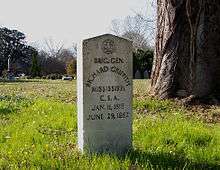Richard Griffith (general)
| Richard Griffith | |
|---|---|
 Richard Griffith | |
| Born |
January 11, 1814 Philadelphia, Pennsylvania |
| Died |
June 29, 1862 (aged 48) Richmond, Virginia |
| Place of burial | Greenwood Cemetery, Jackson, Mississippi |
| Allegiance |
|
| Service/branch |
|
| Years of service | 1846–1847, 1861–1862 |
| Rank |
|
| Unit | Army of Northern Virginia |
| Commands held | Griffith's Brigade |
| Battles/wars | |
| Other work | banker, U.S. marshal, Mississippi state treasurer |
Richard Griffith (January 11, 1814 – June 29, 1862) was a brigadier general in the Confederate States Army during the American Civil War. He was mortally wounded at the Battle of Savage's Station during the 1862 Peninsula Campaign. He was one of a number of Confederate generals who were born in the North in Pennsylvania.
Early life and career
Griffith was born in Philadelphia, Pennsylvania. After graduating from Ohio University in Athens, Ohio, he moved to Vicksburg, Mississippi. During the Mexican War, he served as an infantryman with the 1st Mississippi Rifles, where he met and became friends with Colonel Jefferson Davis.
After the war, he returned to civilian life and made his living as a banker and a U.S. Marshal. He was active in state and local politics, and was elected as the State Treasurer of Mississippi in 1847. He was a member of the antebellum state militia, holding the rank of brigadier general.
Civil War service

When the Civil War began, Griffith was appointed as the colonel of the 12th Mississippi Infantry in May 1861. He was promoted to brigadier general on November 2 and put in command of a brigade of four Mississippi regiments that became part of Maj. Gen. John B. Magruder's division in April 1862.
He soon saw action in the Seven Days Battles near Richmond, Virginia. It was during this fighting that General Griffith was mortally wounded. On June 29, 1862, Griffith and his men were pursuing Union soldiers retreating from positions on the Nine Mile Road when they encountered elements of Maj. Gen. Edwin V. Sumner's II Corps near Savage's Station, who were guarding the Union forces' retreat. In heavy artillery fire, Griffith was wounded in his thigh by a shell fragment.[1]
When he was informed that he was fatally wounded, it is reported that General Griffith said, "If only I could have led my brigade through this battle, I would have died satisfied." Griffith was taken to Richmond, but succumbed to his wounds the same day. He is buried in Greenwood Cemetery in Jackson, Mississippi.
Legacy
The loss of General Griffith was much lamented by many, including his long-time friend Jefferson Davis. Of the fighting at Savage's Station he wrote, "Our loss was small in numbers, but great in value. Among others who could ill be spared, here fell the gallant soldier, the useful citizen, the true friend and Christian gentleman, Brigadier General Richard Griffith. He had served with distinction in foreign war, and, when the South was invaded, was among the first to take up arms in defense of our rights."[2]
Later in the war, a group of soldier-musicians called "The McLaws Minstrels," serving under Lafayette McLaws and formerly under General Griffith, would play at a theater in Fredericksburg. They charged a modest admission fee, the proceeds from which were used to erect a monument in the Mississippi State Capitol in honor of their fallen commander.[3]
See also
Notes
- ↑ Smith, Derek (2005). The Gallant Dead: Union and Confederate Generals Killed in the Civil War. Stackpole Books. ISBN 0-8117-0132-8.
- ↑ Davis, Jefferson (1881). The Rise and Fall of the Confederate Government. University of Michigan: D. Appleton and Co.
- ↑ Sears, Stephen W. (1998). Chancellorsville. Houghton Mifflin. ISBN 0-395-87744-X.
References
- Davis, Jefferson (1881). The Rise and Fall of the Confederate Government. University of Michigan: D. Appleton and Co.
- Eicher, John H., and David J. Eicher, Civil War High Commands. Stanford: Stanford University Press, 2001. ISBN 978-0-8047-3641-1.
- Sears, Stephen W. (1998). Chancellorsville. Houghton Mifflin. ISBN 0-395-87744-X.
- Sifakis, Stewart. Who Was Who in the Civil War. New York: Facts On File, 1988. ISBN 978-0-8160-1055-4.
- Smith, Derek (2005). The Gallant Dead: Union and Confederate Generals Killed in the Civil War. Stackpole Books. ISBN 0-8117-0132-8.
- Warner, Ezra J. Generals in Gray: Lives of the Confederate Commanders. Baton Rouge: Louisiana State University Press, 1959. ISBN 978-0-8071-0823-9.
External links
| Political offices | ||
|---|---|---|
| Preceded by William Clark |
Treasurer of Mississippi 1847–1851 |
Succeeded by William Clark |